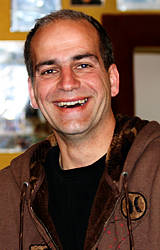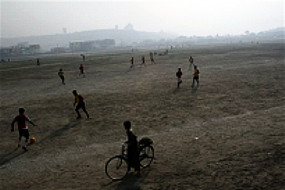 Readers
of this journal and Relational Child & Youth
Readers
of this journal and Relational Child & Youth
Care Practice (among others) will be increasinly
familiar with the refreshing and insightful writing of
Kiaris Gharabachi who has agreed to make a more
regular contribution to CYC-Online
in the future.
We are very pleased to welcome him – Editors
As far as I know, there is no such thing as the
Kandahar Soccer Club but I think there should be. In fact, I don’t think
there are any organized recreational or social gatherings targeting
children or youth in Kandahar; after all, it is a war zone. There are,
however, some adult soccer teams emerging all over Afghanistan,
including in Kandahar (see web sites below), and on at least one
occasion, the Canadian Armed Forces participated in a major soccer
tournament organized for school children
Soccer was the national sport of Afghanistan until the Taliban first
outlawed it, and then restricted it to men wearing full religious dress.
Women and children were prohibited from playing. The problem is that
Kandahar has been a war zone for quite some time, at least if we take a
fairly broad view of what constitutes war. From my perspective, war is
the prevailing condition whenever and wherever the possibility of
coercive intervention is strong; when adults kill and are killed in the
name of a nation, a religion, or a cause, and when children suffer the
consequences of such senseless human slaughter.

In Kandahar, children have not had the opportunity in quite some time to
wake up to a day of endless possibilities, a day of intermingling
between reality and fantasy, a day of playing hide and seek for the sake
of the game rather than for survival. Most have grown up with concepts
and materials that for us are news items, to be viewed and contemplated
in the comfort of our homes: landmines, suicide bombers, kidnappings,
and public beatings/executions.
I think it would be great to start a soccer club for children and youth
in Kandahar (security compliments of the Canadian Armed Forces). And I
think that child and youth workers are the right people for the job.
Here are five reasons why:
We are in the business of creating memories, and kids in Kandahar are in desperate need of memories that don’t involve bullets. In fact, the soccer club would be the context for addressing trauma, in line with our profession's focus on relational practice, engagement and caring.
Child and Youth Care is about bridging cultures through connections. Afghan children and youth have met many foreigners in recent years, but most, well intentioned as they might be, have worn uniforms and carried guns. Imagine the connections we might establish with kids given language issues and very likely profoundly different ways of experiencing the world. A challenge for us, to be sure, but within that challenge lays the opportunity for connective work that transcends all preconceived notions of what a child or youth ought to be like within such connection.
Self is important to us. Hopefully we have learned, as a group of professionals, that we don’t have answers or solutions to every child's problems. What we have is an interest in the Self of the child, and understanding of our own Self, and the courage to be with a child and become “we”. In most of our work environments, our courage is somewhat mitigated by the policy context of our employers and by the bureaucratic directives of the work place. In Kandahar, the only directive is to watch where you step; beyond that, we can actually do child and youth work and be child and youth workers.
We care about children and youth. This is particularly important, given that just about everyone non-Afghan involved in Afghanistan cares primarily about security, geopolitics, and burning up poppy fields to put a dent into the international poppy trade. Sure, there is a lot of money being invested in education in particular, but it still is very much a function of “greater” interests. Child and Youth Workers are unencumbered by the larger political and economic issues of the day. We simply care about kids, and we want to be present with kids where they live.
Last but certainly not least, we need something new, something different. Our work places are not what they used to be. Group homes, schools, hospitals, clinics and custody facilities are heavily regulated, and notwithstanding some really great conceptual thinking in our field, more and more we come across the “bureaucratized Child and Youth Worker"; an individual who does what is asked, reports well in a timely manner, and seeks better and better-paying opportunities through her or his compliance with agency expectations. This is a huge problem. Our discipline emerged from the seemingly untenable position of being thrown together with some very unique youngsters and being asked to make sure all goes according to plan. It is from this chaotic and profoundly open-ended proposition that we found ourselves as a group of professionals that are different. It is from not knowing what to do that we found ways of doing. And it is from this experience that we learned the uselessness of control. We learned that there is no “us and them”, we learned to listen carefully to everybody, colleagues and kids alike, in the hope to be given a clue as to what to do next. Over time, something happened, meant to make things better, but perhaps having the opposite effect. We adopted boundaries, rules, policies and procedures, point and level systems, behaviour management techniques and the deeply entrenched desire to change/fix kids. We improved our language to reflect on what we do, but we abandoned that reflection in favour of confirmation of our value as professionals. Let’s go to Kandahar and find out what we are made of. Forget institutional rules and regulations (but do watch where you step) and rediscover what it is like to be with kids in spaces that are controlled by no one, that require a sense of fear to stay healthy, and where worker and child, and worker and worker, have to rely on each other to move from moment to moment.
There are some practical challenges. The chances of
being blown up, shot or kidnapped are slightly elevated. It’s hard to
get there since there are no commercial flights from North America,
Europe or Africa (there are from some places in the Middle East, India
and Central Asia, albeit all to Kabul, not to Kandahar). And language
might be a bit of a problem, less in dealing with the kids and more so
in terms of living there every day. But surely those details shouldn’t stop us. It hasn’t stopped a US citizen who is offering a soccer program
in partnership with the US Army. And the British Armed Forces are
themselves offering regular soccer matches for fun with kids they
encounter in their work. Both these activities take place in slightly
less volatile regions than Kandahar, emphasis on “slightly”.
So far, I haven’t found too many takers for this idea. Most people just
say “no, thank you”, some write me off as nuts. And this bothers me a
lot. Not because with every passing day, childhood in Afghanistan passes
without the experience of being a child, and not because every so often,
we hear about another “unfortunate” incident where the “liberating” troops kill children by mistake; it bothers me because I am having such
a hard time finding a child and youth worker willing to contemplate
something different, something dangerous, something that is difficult,
perhaps impossible, to control. Putting one’s life at risk is not part
of the job of a child and youth worker, that’s true. But rejecting out
of hand the idea of being with kids in a war zone because it is a war
zone says something about who we have become.
Sure we work with kids in their life spaces, but only the nice ones
please.
Check out the following web sites:
http://www.eurasianet.org/departments/culture/articles/eav032404.shtml
http://www.qantara.de/webcom/show_article.php/_c-478/_nr-189/i.html
http://www.myafghan.com/news2.asp?id=671308238
http://www.forces.gc.ca/site/Feature_Story/2006/11/15_f_e.asp